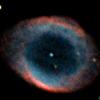I was playing with the new QHY5L-II-M as a guiding camera. While I don't have a good DSO camera yet, I had been playing with the ASI120MC for deep space.
This is NGC2392 (Skimo Nebula)
Not the best ever, but it is fun.
Alvaro


Posted 28 October 2014 - 04:13 PM
Say, that's pretty cool!
I've only tried my '120' on the Moon and Saturn; thanks for the idea ![]()
Posted 28 October 2014 - 05:10 PM
Posted 28 October 2014 - 11:30 PM
Yes,
right now I don't have money for a good DSLR, even less for a descent DSO camera. However, I just got a descent monochromatic camera that I am using it for guiding, so I am getting to practice imaging with the ASI120MC. The guiding is not perfect, but the stars are now rounded and I can use the automatic version of my stacking algorithm. Anyway, the ASI120MC does not give you a big field of view, and with the telescope I am using, an F/10, then the largest nebula that I can fit (and with a lot of pains) is M27 and galaxy is M51. The challenge here is sometimes being able to frame correctly your target. But I can use the practice.
Alvaro
Say, that's pretty cool!
I've only tried my '120' on the Moon and Saturn; thanks for the idea
Bright small targets like planetary nebulae are ideal for this. Double stars and small star clusters are other possible targets. Nice go.
Posted 29 October 2014 - 03:47 PM
I really like your image and the idea of using this camera for dso's. What capture software and settings are you using? Thanks for any suggestions.
Posted 29 October 2014 - 06:05 PM
Your QHY5 might be better for DSO.
use the ASI120 to guide and the QHY to image.
since you are just playing around.
Let us know what you get.
Posted 29 October 2014 - 09:38 PM
I use SharpCap 2 for capturing, the camera is an ASI120MC, and I just started guiding with a QHYL-5-II
I am using and OAG for the guding (for weight and flexure reasons).
these are the camera settings for SharpCap handling my camera for this target
[ZWO ASI120MC]
Output Format=AVI files (*.avi)
Binning=1
Capture Area=1280x960
ColourSpace=RGB24
Sensor Temp=11
Turbo USB=100
White Bal (B)=95
White Bal ®=52
Brightness=0
Gain=50
Gamma=50
Pan=0
Tilt=0
Flip Image=None
Exposure (ms)=15.905414 (its really seconds, this seems a silly bug on SharpCap updating the actual units of the exposure.
I did take a Dark of 20 frames with the same camera settings and I took 2 sets of 100 sub-exposures (each 15.9 seconds)
I average the 20 darks and the subtract each light frame and then I stack it with my simple code in matlab. I tried deepskystacker without success, I think the ASI120MC blooms the stars and drives deepskystaker crazy. That is why I use my own code, because my setup is not that good , or at least not that traditional. The code outputs 32 bits FITS.
At the end I use GIMP2.9 (beta, this version is not that stable but can read 32 bits FITS) to process the level of the image, and sometimes to correct color.
Alvaro
I really like your image and the idea of using this camera for dso's. What capture software and settings are you using? Thanks for any suggestions.
Posted 29 October 2014 - 10:14 PM
You are correct QHY5L is more sensitive, but I am using an AOG for guding, and I am worry that the ASI will not see any stars to help me guide. But yes, I do have some targets in mind that could benefit from a more sensitive camera... Maybe I need another QHY5L? ![]()
Well, I am saving so I can get a canon 6d.
But If get something with the QHY-5L-II, I'll post it.
Alvaro
Your QHY5 might be better for DSO.
use the ASI120 to guide and the QHY to image.
since you are just playing around.
Let us know what you get.
 Cloudy Nights LLC Cloudy Nights Sponsor: Astronomics |